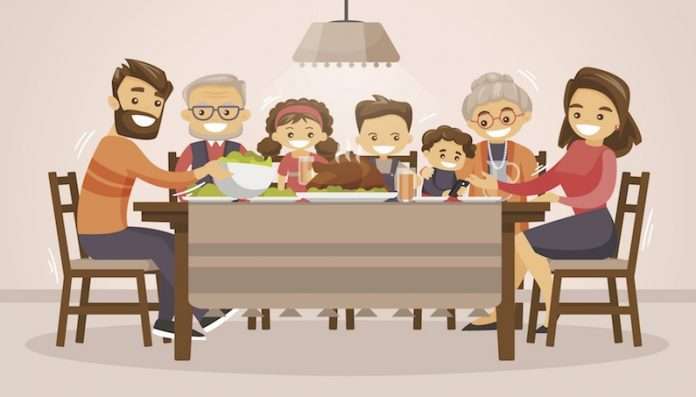During holidays, we often have certain things we always do like family traditions or rituals. Most families probably have traditions that take place throughout the year, but more specifically the holiday traditions seem to stick on to our memories.
Research shows that these traditions are important in building strong family relationships between generations.
Traditions are stories, beliefs, rituals and customs that are passed from one generation to the next. Keeping traditions for the holidays as well as the ordinary days help teach children the things their family values.
These traditions help fill the individual’s need to belong. Being a part of the special things our family does, helps us to have that sense of belonging.
Research shows us that routines and traditions are part of healthy families. Traditions give security to young people, providing a sense of continuity and routine that they can depend on year after year.
Such activities help promote healthy relationships between the generations when they are enjoyed and anticipated by everyone. Children will remember the special experiences of family traditions more than toys and gifts.
To make family traditions more memorable, take the time to talk about the special things your family does and why it is important to you. Include the children in planning and carrying out these special activities.
This will give them a feeling of pride and belonging to actually be a part of the traditions. It also helps them to understand why your family does these special things. If traditions are a part of your religious or cultural heritage, it gives the young people a sense of their family history.
Sometimes, as our families change, our traditions change with us, and that is all right. For example, you can still have the family all get together for a time of sharing and a special meal, but the place or the menu might change over the years.
Most families these days in India are extended ones, wherein, every member has his/her own role, often influenced by age and gender. Children are cherished and considered to be gifts from God.
The family structure in India is typical, wherein, there are many wedding customs which have to be strongly followed by everyone. Religion, caste, traditional practices, and regional differences influence family structures. Indians are more emotionally attached to the members of their families.
Traditional arranged marriages are still popular
The arranged marriage system works thus – families of prospective brides and grooms search for suitable matches, generally within their own community. The decision of marriage is taken collectively by the entire family. Although, gone are the days when the couple didn’t meet each other before the wedding. Today, the couple meets each other before they tie the knot, so as to get acquainted with each other.
In the last few decades, the percentage of love marriages are on the rise, with people preferring to choose their life partners on their own. Either way, in India, marriages are considered to be a union of the families, rather than that of just two individuals. Indian families are based on a few values and principles. These play a very important role in one’s life.
Huge Indian joint family living together under one roof
The very basis of the joint family system is the idea of living together under one roof. The family including the grandparents, parents, siblings, along with the extended family that includes uncles, aunts, and cousins, stay together in harmony.
The culture of a joint family system still prevails in major parts of India. Even in case of the newly developed concept of a nuclear family, the very idea of members living together exists. The essence of togetherness prevails, even if the family members do not share the same roof.

Sharing of responsibilities and rights
Indian families stay together and share responsibilities. Family means more than just staying together. It also means sharing of family duties.The older members of the family share the responsibilities of running the household, taking kitchen-related decisions, and also the ones regarding the general well-being of the family.
In the case of joint families, day-to-day household work is shared amongst members, thus reducing overall work pressure. In the traditional Indian family structure, the mother-in-law hands over the ‘keys’ of the household to the newly married daughter-in-law.
This indicates that the mother-in-law is entrusting the responsibilities of the family to the new member, and also entitling her to enjoy all the rights of the same. The son shares the responsibilities of his father by giving him the financial and emotional support that he needs. Family property in India, as of today, is equally distributed amongst all children
In the traditional structure, the sons of the family have a share in their paternal property. The property is equally shared amongst the sons, and it is handed over to them after the demise of the parents.After the recent law passed by the Government of India, daughters have a share in their parent’s property.
Indian families treat the elderly with utmost respect
The aged members of the family are duly respected by the younger ones.Even after the parents have grown old and are not breadwinners, they still are the ‘decision-makers,decision is taken without their consent.This is not because of the age factor, but because of the respect and love that all family members have for them.
The very gestures of ‘Namaste’ and ‘touching offeet’ of the elders are a mark of respect.
India is rich in its traditional values and customs. The hierarchical structure is followed and due respect is given not only to the members ranking above, but also to the members ranking below, in the hierarchy. Even the kids in the family are addressed with great respect.
In the traditional Indian family, the head of the family is given utmost importance. He is the breadwinner, and the family’s responsibility is entrusted on him. It’s only after his retirement that his son(s) steps into his shoes. The aged parents continue to live with their children, even after they retire.
The country’s cultural values are beautifully penned down by many writers. Mark Twain, in one of his writings, gave a glimpse of this traditional structure. He quoted,
“India is the cradle of the human race, the birthplace of human speech, the mother of history, the grandmother of legend, and the great-grandmother of tradition. Our most valuable and most astrictive materials in the history of man are treasured up in India only!”
Indian family life follows the rich culture of the nation; rituals and traditions prevail
Husbands and wives generally do not display their affection towards each other in front of the elders in the family. In many traditions, women generally cover their heads as a mark of respect, in front of the elderly men in the family. Though, with the increasing number of working women, this tradition of “purdah” is disappearing in the cities, but the respect still lives on.
Contrasts to common belief, women in Indian families are given the same amount of respect and importance as their male counterparts. Today, due to women liberation and the two-income concept, the role of women in Indian families has doubled up. They are paralleling the role of the breadwinner in the house.
In ancient Indian society also, there are glimpses of women empowerment. Sanghamitra, the daughter of famous King Ashoka, went to Sri Lanka to preach Buddhism. However, one cannot ignore the fact that there are many Indian women who still suffer from the evil of gender bias.

Financial Support
Indian families span the poor, middle-class, and the rich; lifestyles vary accordingly. There is also a variety of living conditions in India. Rich urban families enjoy modern homes, maids, caretakers, and cars; whereas, the middle-class usually lives in apartments or smaller homes.
Poor families live in simple huts or roofed houses.The living standards don’t matter much to the people, as they expect peace and life satisfaction, rather than riches or financial prosperity. Large joint families live in big houses that have many rooms.
Changing Trends in Indian Families
Modern Indian families have adopted a lot of western practices. Nowadays, traditional roles are changing, especially in urban areas. There are important values shared and followed by most Indian families.But today’s young generation, who is into the modern age, don’t seem to like the traditions and family practices that have been followed by their families for decades.
They are more inclined towards western culture and lifestyle.Indians generally hold family progress, unity, and support, in high regard throughout their lives. Lately, more and more people are opting for ‘live-in’ relationships, a concept that is borrowed from the West.
The discussion on family life in India can be continued further, as there are many more interesting things about it. In its entirety, it would suffice to know that the people in India look up to family life, and this is evident in the dedication of every member within the family.
Traditions help to bind us together as a family. Make it a point this year to include your children in family traditions that will provide them with a sense of belonging and build memories for their future.
(The views expressed are the writer’s own)

Gurpreet kour
Bhawanipatna, Odisha. Dist: kalahandi
You can reach her at: [email protected]
( Images from the net)

